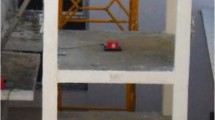Abstract
Vibration-based structural health monitoring (SHM) is based on the fact that changes in the dynamic characteristics of a structure are associated with structural damages. Deterioration in reinforced concrete (RC) bridge deck slabs is often observed during their service life due to fatigue and rebar corrosion leading to internal deterioration and damage, such as horizontal cracks. Since the internal deterioration and damage of RC slabs are often difficult to detect by visual inspection, a study was carried out to investigate such damages through vibration-based SHM. This study investigated experimentally the effect of horizontal crack and damage at different loading states, from 0 kN to load after failure, on the modal properties of RC slabs. Eigensystem realization algorithm and continuous wavelet transform approaches were adopted to identify the modal properties. Finite element model was developed to compare the experimental modal properties to the numerical ones. Changes in the natural frequency, modal damping ratio and coordinate modal assurance criteria were found to be correlated with damage. The correlation between damping ratio and damage was improved by considering the amplitude dependence of damping ratio. Investigation of amplitude-dependent damping behavior of RC slabs indicated variation in the slope of correlations between the amplitude and damping ratios with the vibration mode and structure condition in different loading states.













Similar content being viewed by others
References
Ikehata S, Ishiguro H, Nakano T, Nakamura H (2020) Experimental evaluation of punching shear capacity of reinforced concrete slabs with horizontal crack due to compression rebar corrosion. Struct Concr. https://doi.org/10.1002/suco.201900438
Ewins DJ (2000) Modal testing: theory, practice and application, 2nd edn. Research Studies Press Ltd., Baldock
Kong X, Cai CS, Hu J (2017) The state of the art on framework of vibration based structural damage identification for decision making. Appl Sci 7(5):1–31. https://doi.org/10.3390/app7050497
Salawu OS (1997) Detection of structural damage through changes in frequency: a review. Eng Struct 19(9):718–723. https://doi.org/10.1016/S0141-0296(96)00149-6
Curadelli RO, Riera JD, Ambrosini D, Amani MG (2008) Damage detection by means of structural damping identification. Eng Struct 30(12):3497–3504. https://doi.org/10.1016/j.engstruct.2008.05.024
Nandan H, Singh MP (2014) Effects of thermal environment on structural frequencies. II: a system identification model. Eng Struct 81(28):491–498. https://doi.org/10.1016/j.engstruct.2014.07.042
Huang MS, Gul M, Zhu HP (2018) Vibration-based structural damage identification under varying temperature effects. J Aerosp Eng 31(3):04018014. https://doi.org/10.1061/(ASCE)AS.1943-5525.0000829
Shi ZY, Law SS, Zhang LM (2000) Damage detection in existing reinforced concrete building using forced vibration test based on mode shape data. J Eng Mech 126(6):656–660. https://doi.org/10.1061/(ASCE)0733-9399(2000)126:6(656)
Tatar A, Niousha A, Rofooei FR (2017) Damage assessment through changes in mode shapes due to non-proportional damping. J Civ Struct Health Monit 7:123–135. https://doi.org/10.1007/s13349-017-0209-8
Dammika AJ, Kawarai K, Yamaguchi H, Matsumoto Y, Yoshika T (2015) Analytical damping valuation complementary to experimental structural health monitoring of bridges. J Bridge Eng 20(7):04014095. https://doi.org/10.1061/(ASCE)BE.1943-5592.0000691
Mustafa S, Matsumoto Y, Yamaguchi K (2018) Vibration-based health monitoring of an existing truss bridge using energy-based damping evaluation. J Bridge Eng 23(1):04017114. https://doi.org/10.1061/(ASCE)BE.1943-5592.0001159
Lorenzoni F, Conto ND, Porto Fd, Modena C (2019) Ambient and free-vibration tests to improve the quantification and estimation of modal parameters in existing bridges. J Civ Struct Health Monit 9:617–637. https://doi.org/10.1007/s13349-019-00357-4
Avci O (2016) Amplitude-dependent damping in vibration serviceability: case of laboratory footbridge. J Archit Eng 22(3):04016005. https://doi.org/10.1061/(ASCE)AE.1943-5568.0000211
Ye X, Huang P, Pan C, Mei L (2021) Innovative stabilization diagram for automated structural modal identification based on ERA and hierarchical cluster analysis. J Civ Struct Health Monit 11:1355–1373. https://doi.org/10.1007/s13349-021-00514-8
Arici Y, Mosalam KM (2005) Statistical significance of modal parameters of bridge systems identified from strong motion data. Earthq Eng Struct Dyn 34(10):1323–1341. https://doi.org/10.1002/eqe.482
Shahsavari V, Bastien J, Chouinard L, Clement A (2017) Likelihood-based testing of wavelet coefficients for damage detection in beam structures. J Civ Struct Health Monit 7:79–98. https://doi.org/10.1007/s13349-017-0212-0
Wijesundara KK, Negulescu C, Foerster E (2015) Estimation of modal properties of low-rise buildings using ambient excitation measurements. Shock Vib 15:173450. https://doi.org/10.1155/2015/173450
Juang JN, Pappa RS (1985) An eigensystem realization algorithm for modal parameter identification and model reduction. J Guid Contol Dyn 8(5):620–627. https://doi.org/10.2514/3.20031
Torrence C, Compo GP (1998) A practical guide to wavelet analysis. Bull Am Meteorol Soc 79(1):61–78. https://doi.org/10.1175/1520-0477(1998)079%3c0061:APGTWA%3e2.0.CO;2
Mallet S (2009) A wavelet tour of signal processing: the sparse way, 3rd edn. Acadamic Press, Burlington. https://doi.org/10.1016/B978-0-12-374370-1.X0001-8
Kijewski T, Kareem A (2003) Wavelet transform for system identification in civil engineering. Comput Aided Civ Infrastruct Eng 18(5):339–355. https://doi.org/10.1111/1467-8667.t01-1-00312
Moughty JJ, Cases JR (2017) A state of the art review of modal-based damage detection in bridges: development, challenges, and solutions. Appl Sci 7:510. https://doi.org/10.3390/app7050510
Maia NMM, Silva JMM (eds) (1997) Theoretical and experimental modal analysis. Research Studies Press Ltd., Somerset
Carne TG, Griffith DT, Casias ME (2007) Support conditions for free boundary-condition modal testing. In: Proceedings of the 25th international modal analysis conferencem Orlando, Florida, USA
Acknowledgements
Authors are thankful to staff of Kanto Regional Head Office of NEXCO EAST, and Mr. Kyosuke Yamaura, a former graduate student of Saitama University, for their support in conducting the experiment described in this paper.
Author information
Authors and Affiliations
Corresponding author
Ethics declarations
Conflict of interest
The authors have no competing interests to declare that are relevant to the content of this article.
Additional information
Publisher's Note
Springer Nature remains neutral with regard to jurisdictional claims in published maps and institutional affiliations.
Rights and permissions
Springer Nature or its licensor holds exclusive rights to this article under a publishing agreement with the author(s) or other rightsholder(s); author self-archiving of the accepted manuscript version of this article is solely governed by the terms of such publishing agreement and applicable law.
About this article
Cite this article
Gohar, S., Matsumoto, Y., Maki, T. et al. Investigation into vibration-based structural damage identification and amplitude-dependent damping ratio of reinforced concrete bridge deck slab under different loading states. J Civil Struct Health Monit 13, 133–148 (2023). https://doi.org/10.1007/s13349-022-00625-w
Received:
Accepted:
Published:
Issue Date:
DOI: https://doi.org/10.1007/s13349-022-00625-w




